Bacteriology
5.0(1)
5.0(1)
Card Sorting
1/79
There's no tags or description
Looks like no tags are added yet.
Study Analytics
Name | Mastery | Learn | Test | Matching | Spaced |
|---|
No study sessions yet.
80 Terms
1
New cards
Describe the bacteria surface structure of gram +
\-teichoic acid and lipoteichoic acid
\-thick layer of peptidoglycan
\-S layer
\-plasma membrane
\-thick layer of peptidoglycan
\-S layer
\-plasma membrane
2
New cards
Describe the bacteria surface structure of gram -
\-LPS in outer membrane
\-thin layer of peptidoglycan on the periplasmic space
\-plasma membrane
\-thin layer of peptidoglycan on the periplasmic space
\-plasma membrane
3
New cards
What is the role of peptidoglycan?
A rigid structure to give the bacteria the shape and protect it from external agressors
4
New cards
How does peptidoglycan synthesis work?
It is directed from the cytoplasm with the help of bacterial tubulin and actin, then at the surface of the cell, the peptidoglycan flips onto the other side of the cell wall and then there is transglycosylation and transpeptidation
5
New cards
what are the 2 main sugar components of peptidoglycan structure?
1\.Muramic acid
2\.glucosamin
2\.glucosamin
6
New cards
what are the main amino acid components of peptidoglycan structure?
Ala
Glu
L-lys
Glu
L-lys
7
New cards
What is PBP?
Penicillin binding protein, which are targeted by penicillins
8
New cards
Explain briefly the MOA of vancomysin
Vancomysin binds directly to the peptidoglycan and stops the transglycosylation and transpeptidation from happening.
9
New cards
What is the name of the bacteria “actin” and “tubulin”?
actin→ MreB
tubulin →FtsZ
tubulin →FtsZ
10
New cards
What host receptor can sense peptidoglycan?
NOD-like receptors such as NOD-1 and NOD-2
11
New cards
Lysozymes can cleave peptidoglycan as part of its host defenses, where does it cleave?
Between N-acetyl Glucosamin (NacG) and N-acetyl-muramic acid (NacMur)
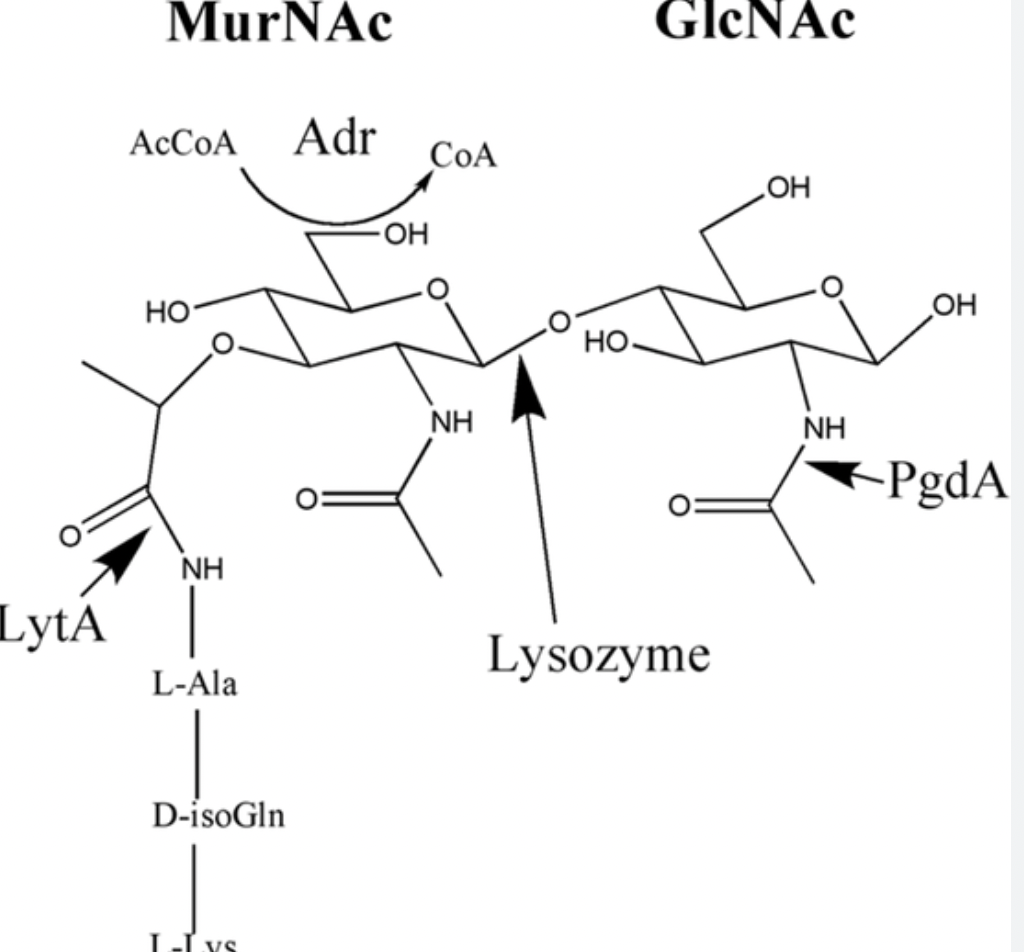
12
New cards
Explain the mechanism of lysozyme resistance that bacteria have developed:
By N-deacetlyation, lysozyme can no longer cleave

13
New cards
Explain one way (except for lysozyme resistance) that bacteria can escape the host defenses:
Formation of capsules
14
New cards
What are capsules formed from?
Polysaccharides and polypeptides (like polyglutamate)
15
New cards
What is the main role of capsules?
It allows the bacteria to evade phagocytosis by masking the epitopes
16
New cards
PAMPS are recognized by pattern recognition receptors such as ……. AND …….
Toll-like receptors and Nod-like receptors
17
New cards
LPS and Flagella are examples of ……..?
PAMPS
18
New cards
Recall the structure of TLR’s
They are type 1 transmembrane proteins with a domain containing leucin-rich repeats
19
New cards
Which TLR’s recognize extracellular PAMPS?
1, 2, 4, 5, 6, 11
20
New cards
Which TLR’s recognize endolysozome PAMPS?
3, 7, 8, 9, 10
21
New cards
Draw and explain the intracellular signalling pathway when TLR 4 is activated
Upon signalling of a PAMP, TLR 4 is activated, activating **MyD88**. This in turn will activate **IRAK4** which autophosphorylated into IRAK1/2. This will activate TRAF 6 which in turn activates **TAK1 and IKK** through phosphorylation. This activates INK and MAPK leading to the activation of the transcription factor NF-KB leading to the expression of genes coding for cytokines and other molecules used in defense.
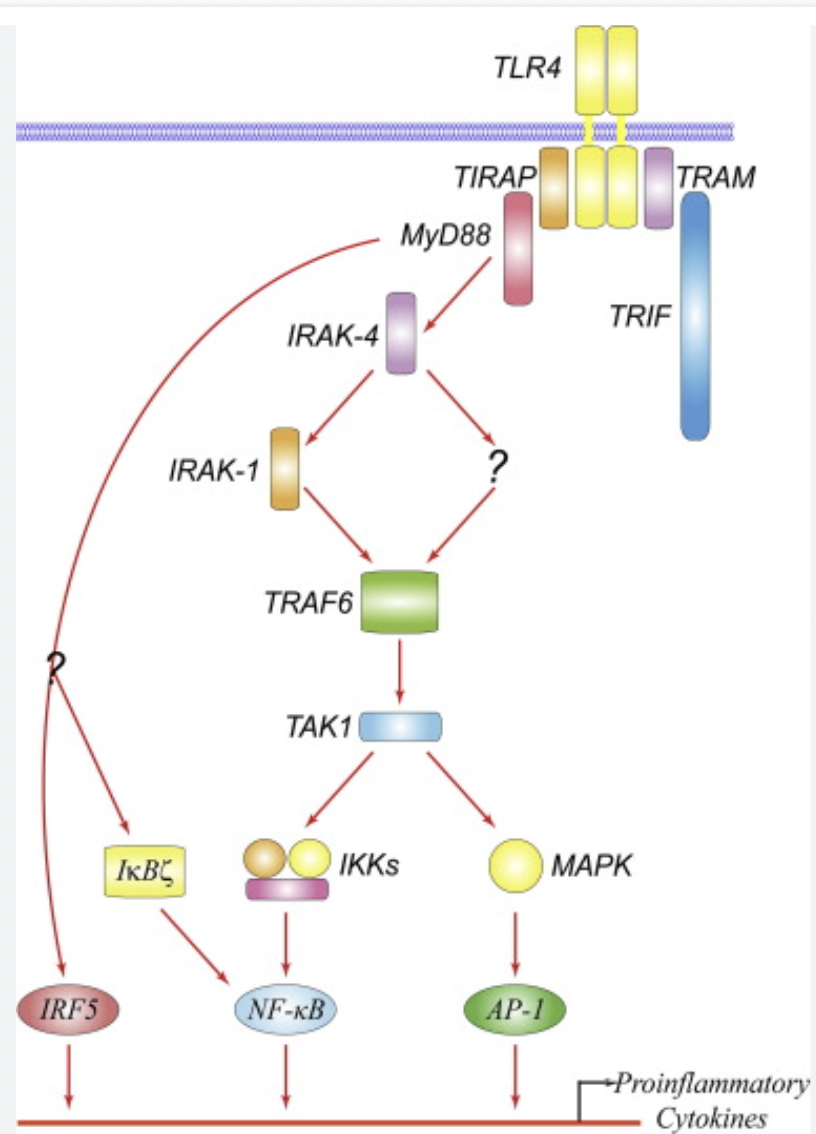
22
New cards
Draw and explain the intracellular signalling pathway when TLR 7, 8 or 9 is activated
Activation of MyD88 leads to the activation of IRAK4 through phosphorylation which in turn will phosphorylate IRAK1/2 and activate TRAF6. This will lead to activation of TAK1 through ubiquitinization which will also activate IKK and MAPK. This will lead to the translocation of some transcription factors such as NFkB into the nucleus where it will act on the DNA and lead to the expression of genes such as the ones coding for type 1 interferons.
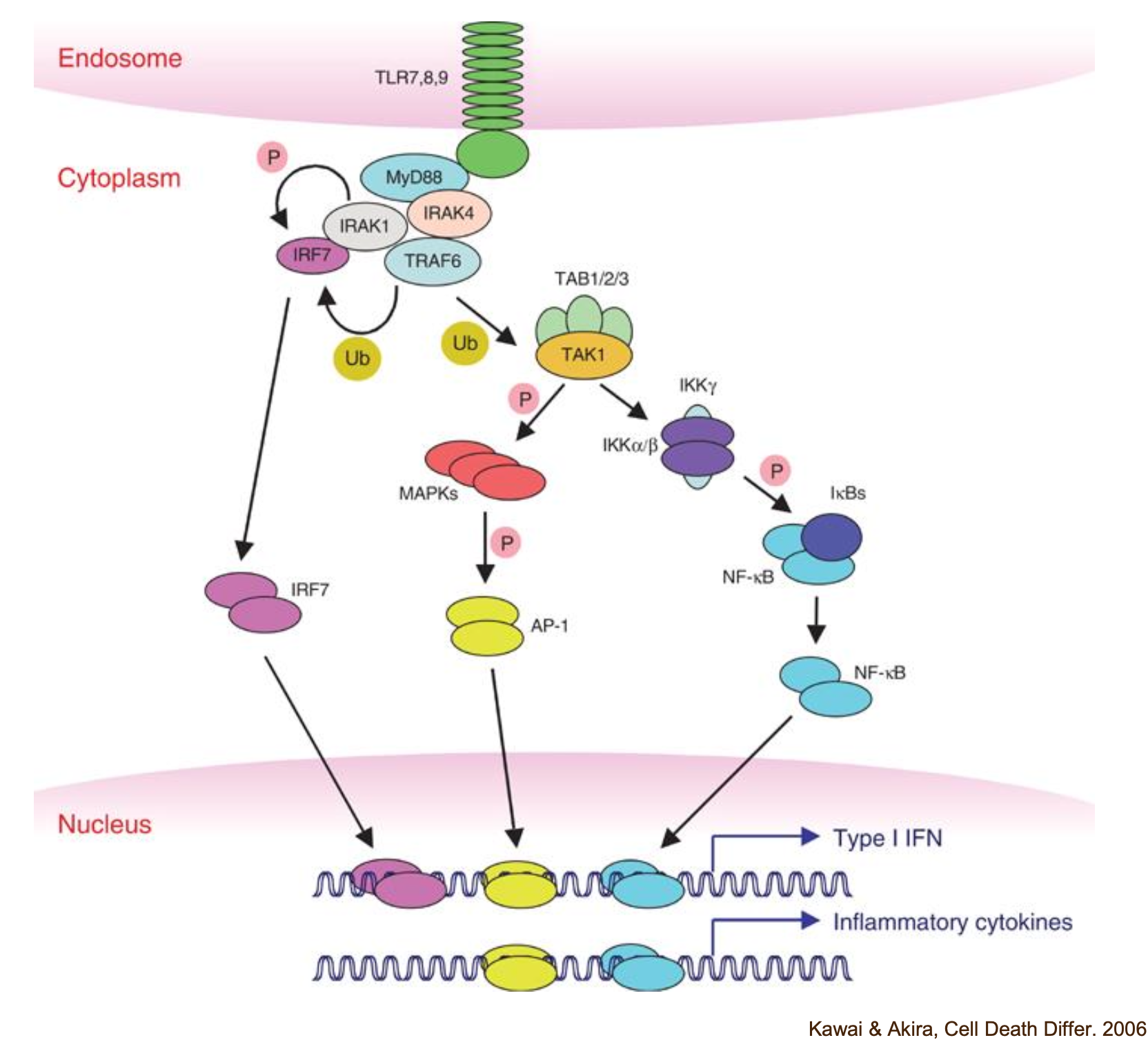
23
New cards
What kind of cytokine is expressed as a result of TLR7 activation?
Type 1 interferons
24
New cards
Draw and explain the intracellular signalling pathway when TLR 3 is activated
Activation of TLR 3 leads to the activation of TRIF. TRIF then activates other signalling molecules such as TRAF6, this will ubiquitinate TAK1 to activate it which will activate IKK and MAPK. Leading to the translocation of transcription factors like NFkB which will lead to the expression of cytokines
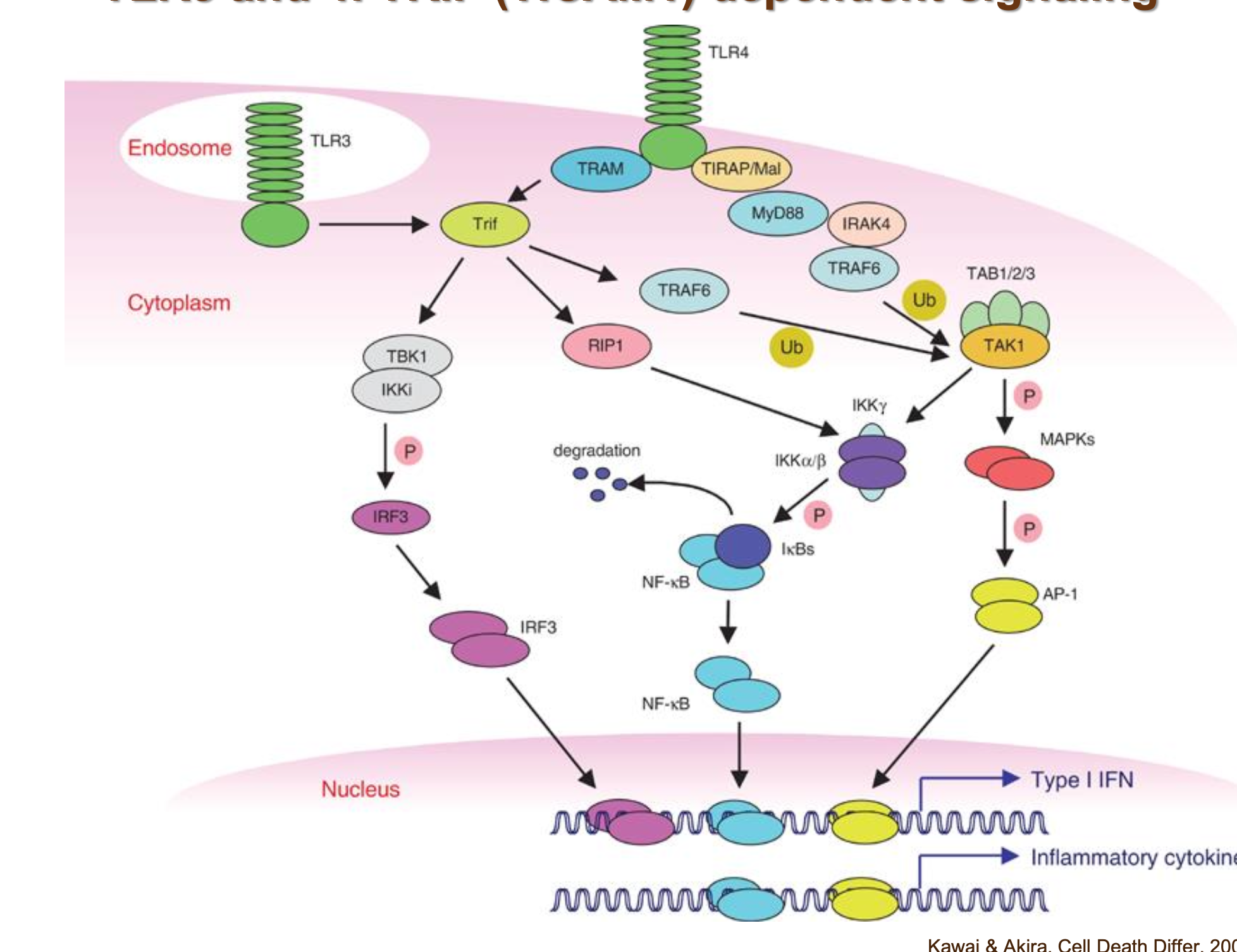
25
New cards
Recall the 3 domains of NLR
1\.The ligand-sensing Leucine-rich repeat domain
\
2\.The nucleotide binding domain (NBD)
\n 3.The caspase recruitment domain family (**CARD**)
\
2\.The nucleotide binding domain (NBD)
\n 3.The caspase recruitment domain family (**CARD**)
26
New cards
NLR activation leads to the formation of an ……….. through the recruitment of …………….
**Inflammasome** through the recuitment of **caspase 1**
27
New cards
Briefly explain the NLR signalling pathway
NOD-1 or NOD-2 is activated upon signal, which will activate **RIP2** which mediates ubiquitination of **NEMO/IKKγ** leading to the activation of **NF-k**B and the production of inflammatory cytokines. In parallel, poly-ubiquitinated RIP2 recruits **TAK1**, which leads to **IKK** complex activation and the activation of **MAPKs.**
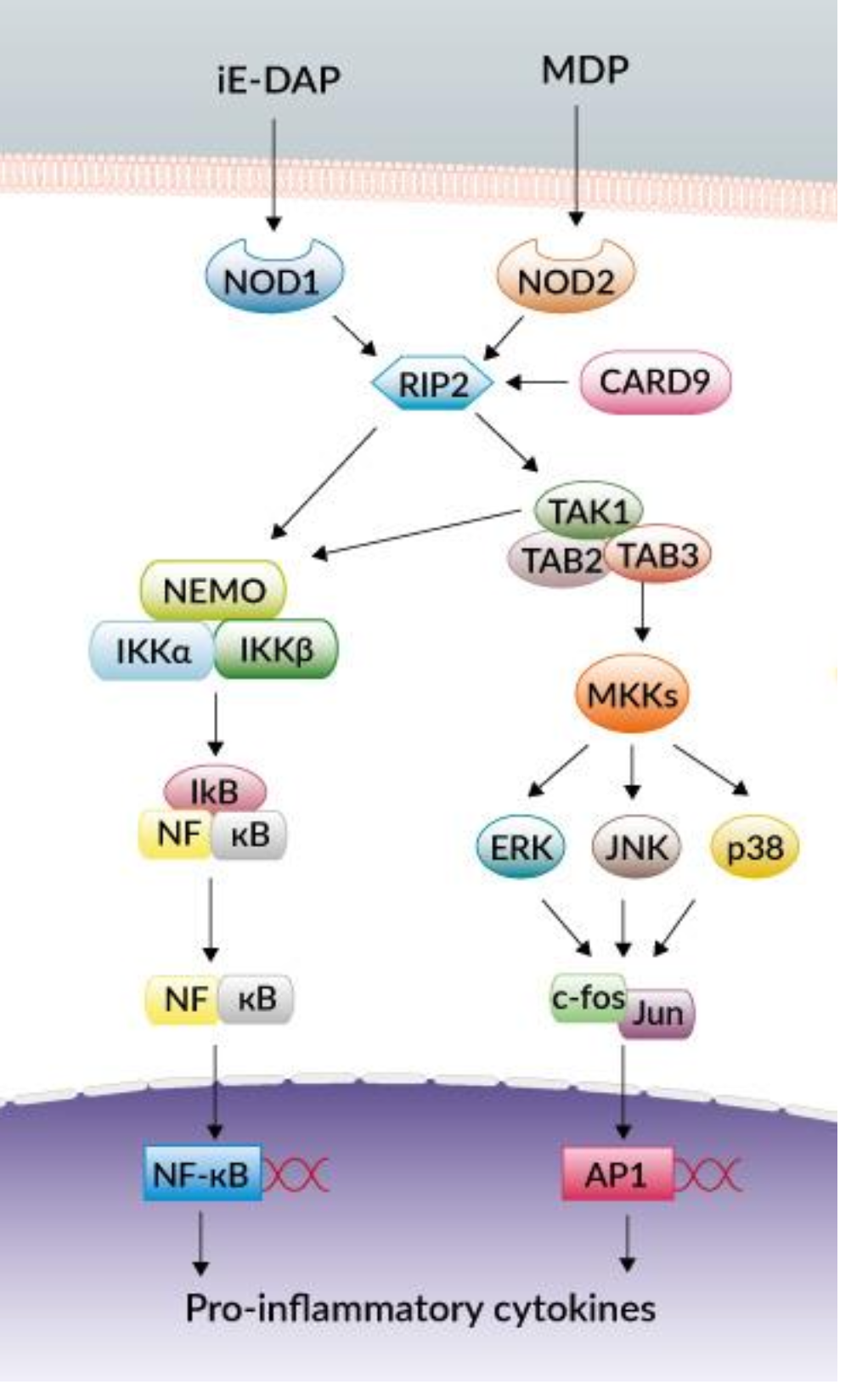
28
New cards
what are the two pathways of inflammasome?
Canonical and non-canonical
29
New cards
The **canonical** pathway is also known as the …….. inflammasome
NLRP3
30
New cards
Explain how the NLRP3 inflammasome is formed:
First, NLRP3 senses a signal, this activates it and allows it to change its conformation. This then leads to its oligomerization. Then, several NLRP3 join in order to form a PYD ring, which allows to recruit the inflammasome adaptor ASC. The CARD domain then allows to recruit caspase 1. The inflammasome is formed and forms pores in the plasma membrane of the host cell, leading to the leakage of cytokines.
31
New cards
What is an example of an endotoxin observed in many gram neg bacteria?
Lipid A
32
New cards
__Complete the paragraph:__
The O-antigen has high genetic …………, which we use to identify the different ……….., the O-antigen is also sometimes responsible for autoimmune inflammation post infection due to a phenomenon called ………………………...
The O-antigen has high genetic …………, which we use to identify the different ……….., the O-antigen is also sometimes responsible for autoimmune inflammation post infection due to a phenomenon called ………………………...
The O-antigen has high genetic __**variability**__, which we use to identify the different __**serogroups**__, the O-antigen is also sometimes responsible for autoimmune inflammation post infection due to a phenomenon called __**molecular mimicry**__.
33
New cards
Name 3 types of cell-surface appendages in bacteria
1\.Fimbriae
2\.Pili
3\.Flagella
2\.Pili
3\.Flagella
34
New cards
What are some of the functions of Pili?
Adherence, biofilm formation, DNA uptake (e.g horizontal gene transfer), microcolony formation
35
New cards
Briefly recall the structure of flagella and the components different roles
Filament
Hook for energy transmission
C-ring, for direction change
Ms-ring for rotation
Hook for energy transmission
C-ring, for direction change
Ms-ring for rotation
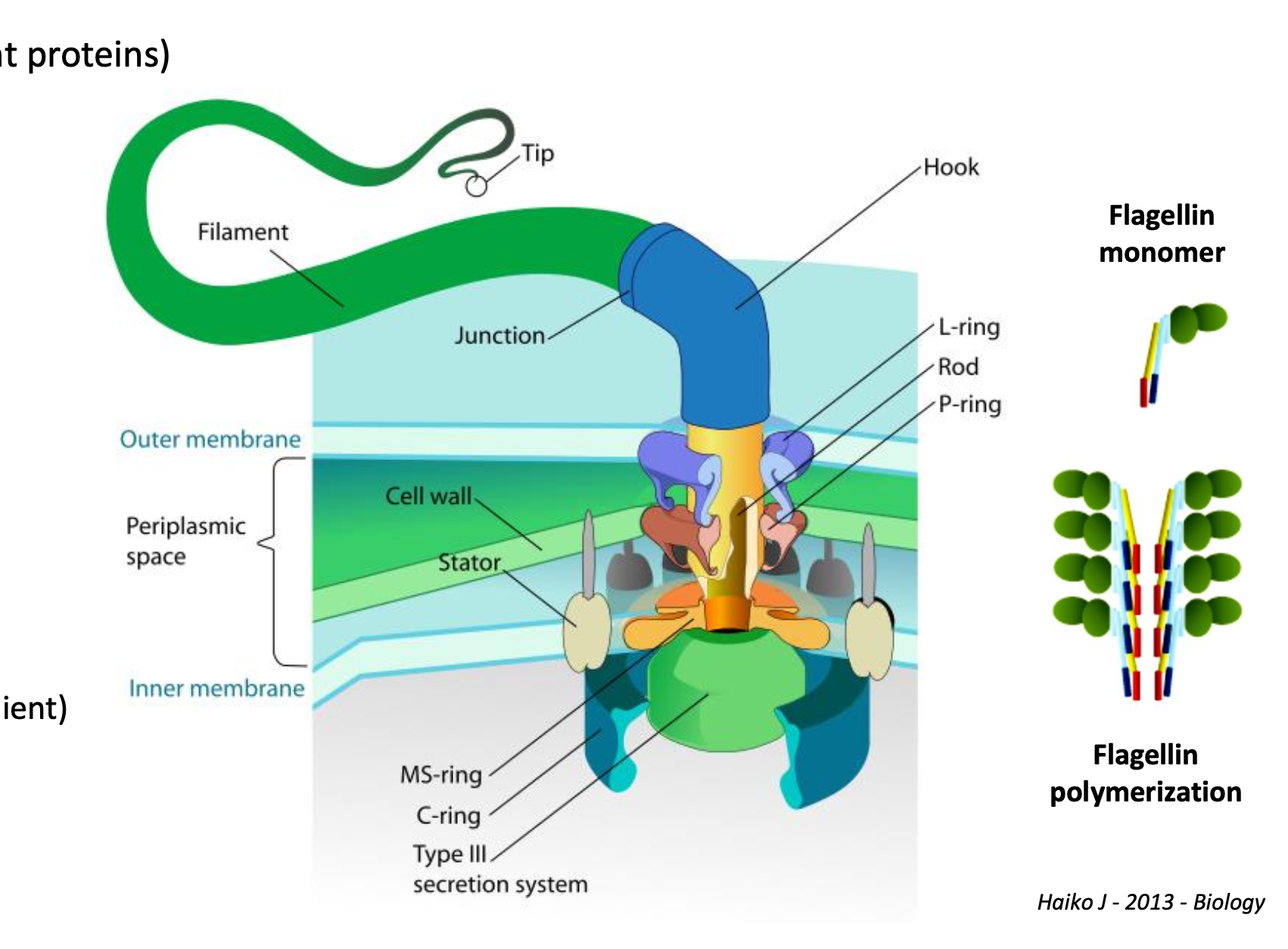
36
New cards
What virulence factor does the flagella give to a bacteria other than its motility?
adhesion
biofilm formation
protein export
biofilm formation
protein export
37
New cards
What kind of toxin is LPS?
endotoxin
38
New cards
Toxins can be stored in what we call pathogenicity ……….
ISLANDS
39
New cards
What are the 3 classes of bacterial toxins?
1\.pore forming toxins (PFT)
2\.toxins with extracellular targets
3\.toxins with intracellular targets
2\.toxins with extracellular targets
3\.toxins with intracellular targets
40
New cards
What are the 2 types of Pore forming toxins (PFT’s)
α PFT (forms alpha helical pores)
β PFT (forms beta barrel pores)
β PFT (forms beta barrel pores)
41
New cards
Give an example of an α PFT
Colicins
42
New cards
Give an example of a β PFT
Hemolysins
43
New cards
Name 2 types of toxin with extracellular target
**Sphingomyelinases, e.g SMase C and SMase D**
**Phospholipases e.g PLase A and B**
**Phospholipases e.g PLase A and B**
44
New cards
How do Sphingomyelinases work?
They target the sphingolipids in eukaryotic cell membranes leading to cell lysis
45
New cards
what are the 3 types of toxins with intracellular targets?
The AB`RT` toxin
The AB`5` toxin
The A`n`B`7` toxin
The AB`5` toxin
The A`n`B`7` toxin
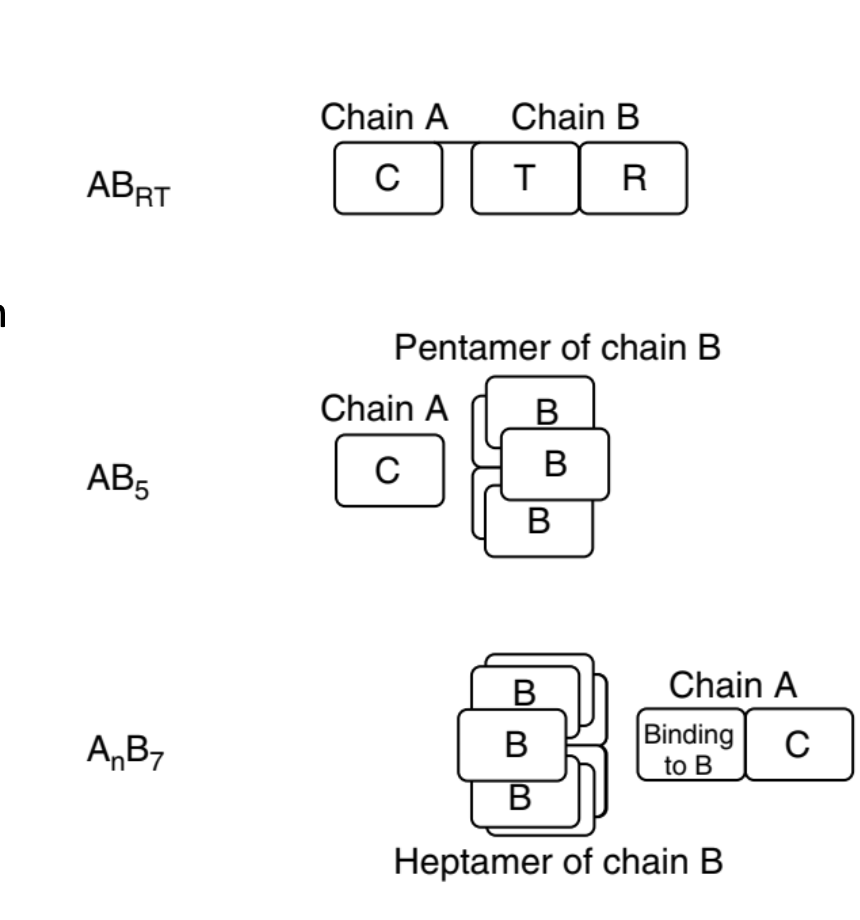
46
New cards
An example of an AB`RT` toxin is the **Botulinum toxins.** How do they work?
Botulinum toxins prevent the release of the acetylcholine from axon endings at the neuromuscular junction, causing paralysis
47
New cards
An example of an AB`RT` toxin is the **Tetanus toxins.** How do they work?
Tetanus toxin blocks the inhibitory interneurons in the CNS producing rigidity, unopposed muscle contraction and spasm
48
New cards
Give an example of an AB`5` toxin
Cholera toxin
49
New cards
Explain the MOA of the cholera toxin
It binds to GM1 ganglioside and histo-blood group antigens and leads to an over activation of the Gs alpha subunit of GTPase which also leads to activation of adenylyl cyclase and accumulation of cAMP. This leads to over activation of PKA, opening of channels and efflux of chloride ions which leads to efflux of H2O, Na+, K+, and HCO3− into the intestinal lumen
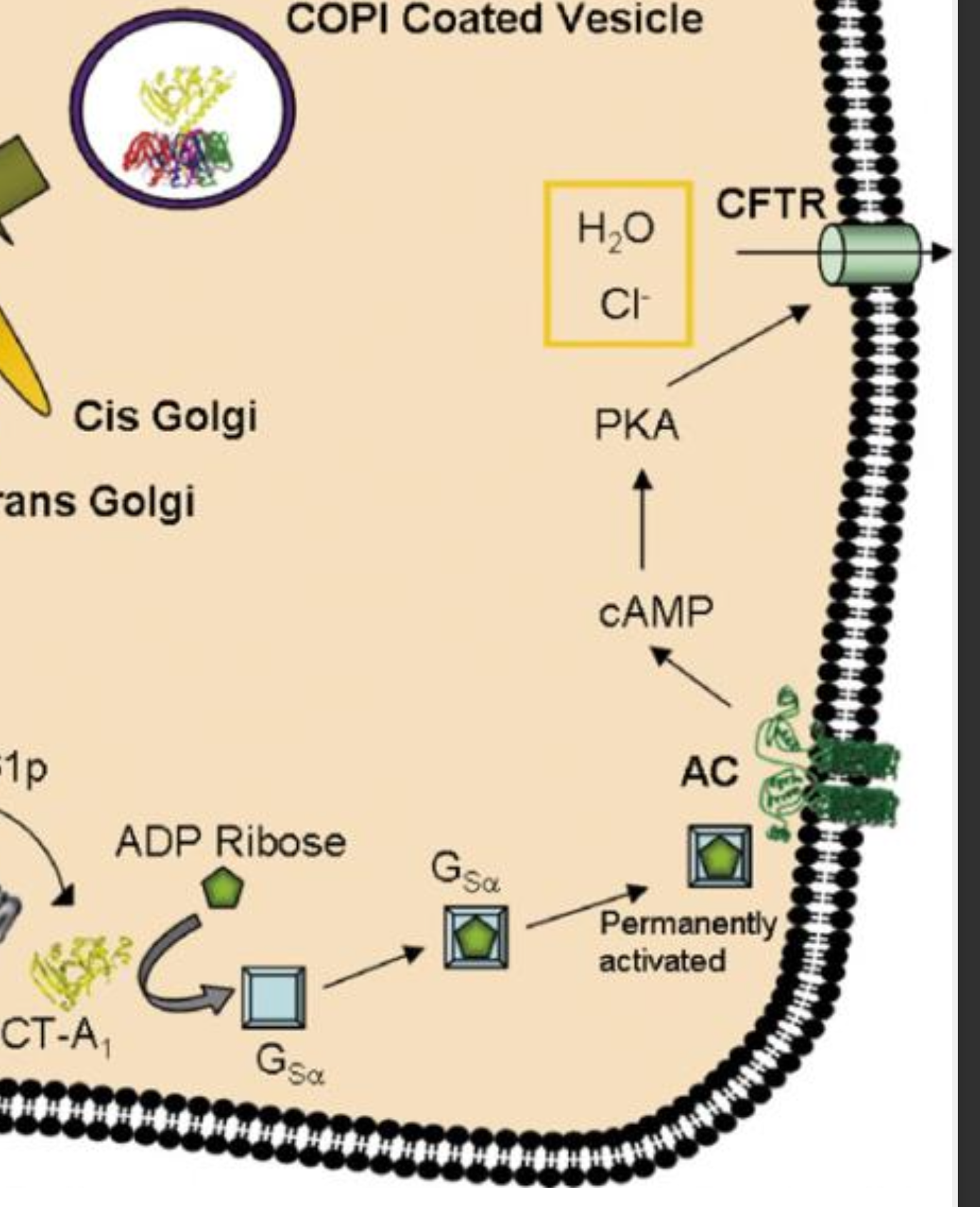
50
New cards
What are the 6 stages of sporulation?
1\.Condensation of chromosomes
2\.Asymetric division
3\.Engulfment
4\.Cortex synthesis
5\.Coat synthesis
6\.Spore release
2\.Asymetric division
3\.Engulfment
4\.Cortex synthesis
5\.Coat synthesis
6\.Spore release
51
New cards
Draw and label a spore
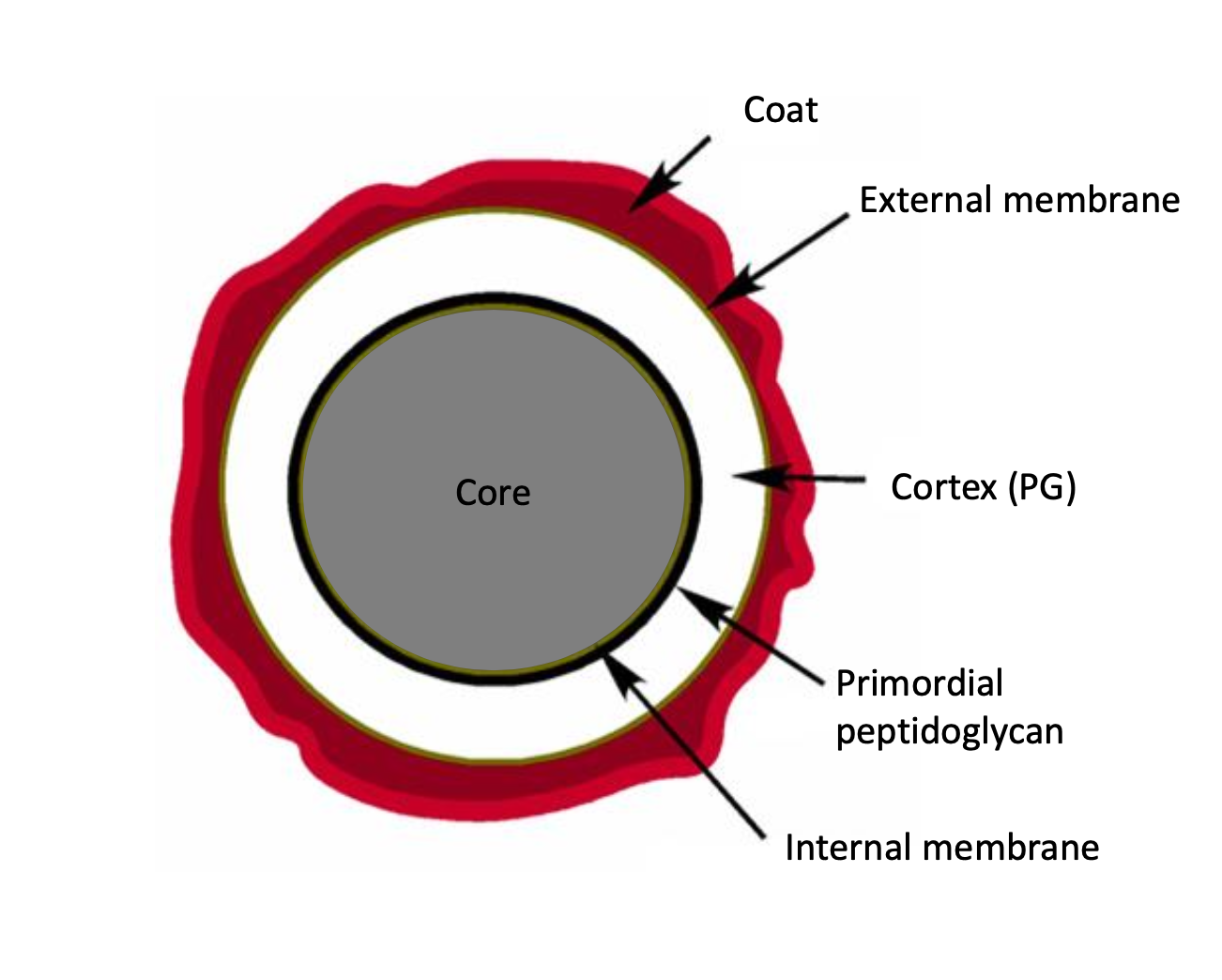
52
New cards
Spores can resist to various stressors such as?
heat
cold
desiccation (dehydration)
chemical compounds
cold
desiccation (dehydration)
chemical compounds
53
New cards
What is the core of a spore composed of?
Dipicoloinic acid
Ca2+
SASP proteins
Ca2+
SASP proteins
54
New cards
The cortex of a spore is made from?
peptidoglycans
55
New cards
__Complete the paragraph:__
Spores are ……….. versions of bacteria that can survive for years. When spores sense certain conditions, it ………… into a growing cell
Spores are ……….. versions of bacteria that can survive for years. When spores sense certain conditions, it ………… into a growing cell
Spores are **dormant** versions of bacteria that can survive for years. When spores sense certain conditions, it **germinates** into a growing cell
56
New cards
Briefly explain the mechanism behind the synthesis of the cortex of a spore.
peptide cleavage→N-deacetylation→Muramic lactam forms
57
New cards
what protein plays an important role in the regulation of sporulation?
Sigma factors :σF, σE, σG, and σK
58
New cards
Briefly explain the regulation of sporulation.
In the forespore, σF activation begins when the phosphatase SpoIIE preferentially activates the anti-anti sigma factor SpoIIAA. Activated SpoIIAA antagonizes anti-sigma factor SpoIIAB binding to σF in the forespore, freeing σF to activate sigG and spoIIR expression. SpoIIR is secreted into the intermembrane space and activates the SpoIIGA protease to remove an inhibitory pro-peptide from σE in the mother cell.
59
New cards
A foreign DNA entry in bacteria must be followed by a specific genetic event to be acquired, what are the 2 types of genetic events?
1\.substitution (homologous recombination)
2\.additon (plasmid integration)
2\.additon (plasmid integration)
60
New cards
Homologous recombination is when a …….. …….. occurs
Homologous recombination is when a __**double cross over event**__ occurs
61
New cards
What is a transposon?
Transposons are DNA sequences able to change their location in the genome.
62
New cards
Transposition implies the presence of ………… and ………… sequences named IR
Transposition implies the presence of __**inverted**__ and __**repeated**__ sequences named IR
63
New cards
What do transposons carry usually?
resistance genes
64
New cards
What is an integron?
Constitute a gene capture and expression system under cassettes form. Integrons are not mobile by them selves, but they are frequently found on transposons or plasmids.
65
New cards
Do cassettes contain functional genes?
Cassettes do not encode a functional gene of the integron.
66
New cards
What is a plasmid?
\-Distinct from the chromosomal DNA \n - Non-essential to the cell survive \n - Able to replicate in an autonomous manner
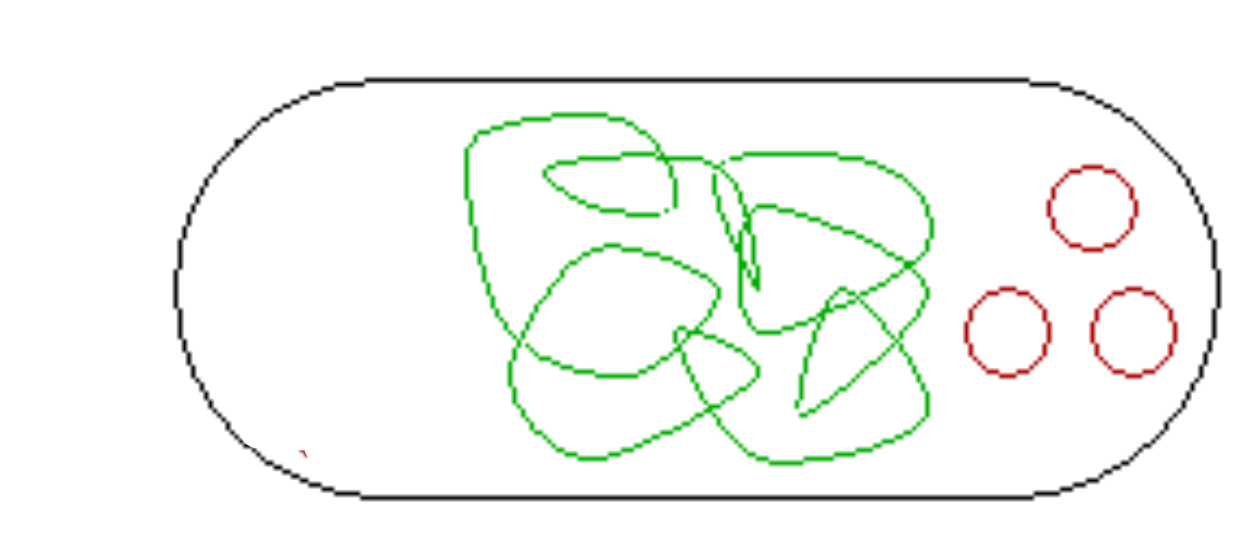
67
New cards
What is natural transformation?
Process by which bacteria can actively take up and integrate exogenous DNA thereby providing a source of genetic diversity
68
New cards
Explain the mechanism of natural transformation:
A dsDNA strand is taken up by a bacteria through a pore. It is then converted to a ssDNA which can either be degraded (in most cases) OR it can integrate to chromosomal DNA through homologous recombination.
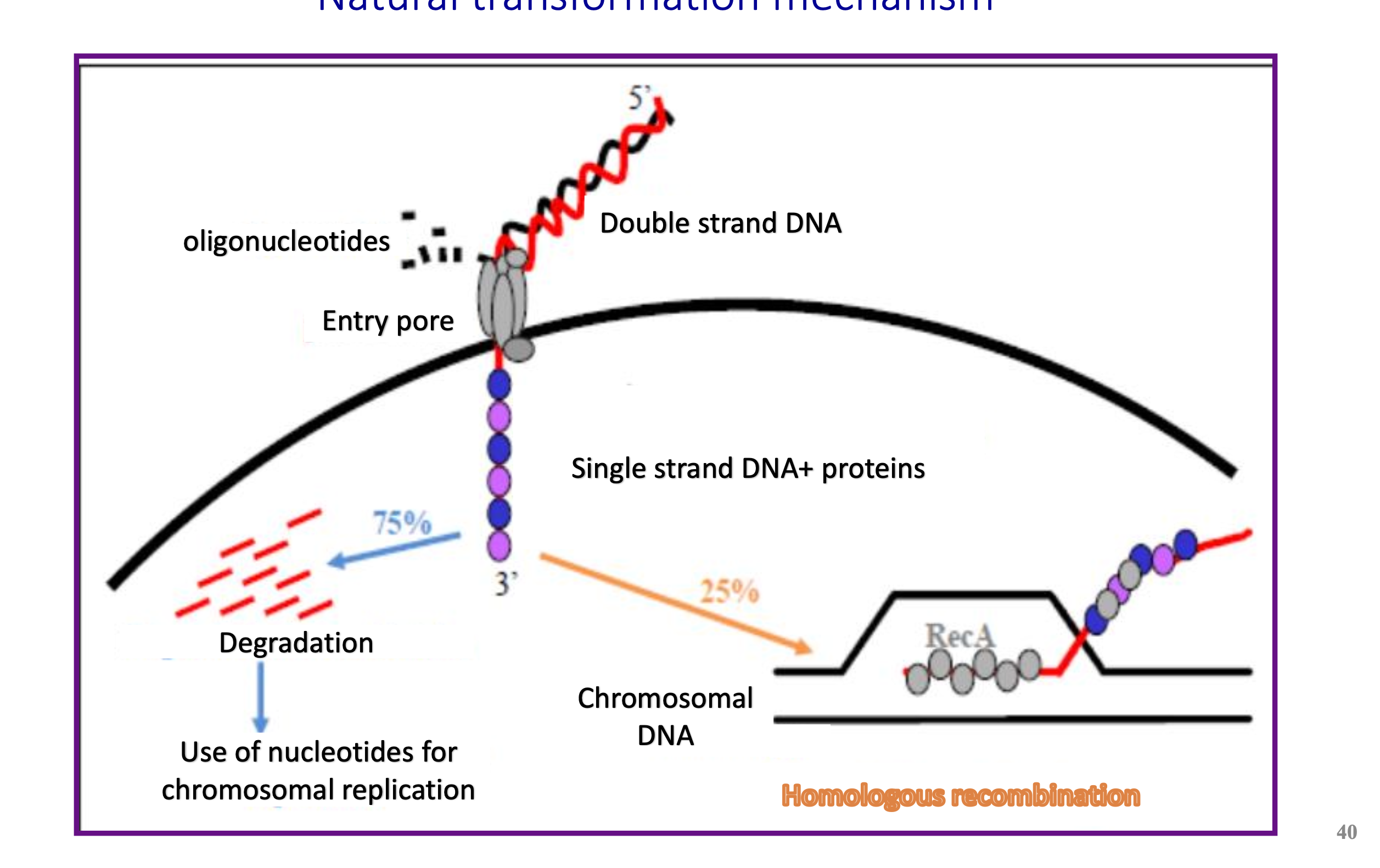
69
New cards
What is conjugation?
Process by which bacteria can transfer genetic material to each other by direct contact, using a pilus
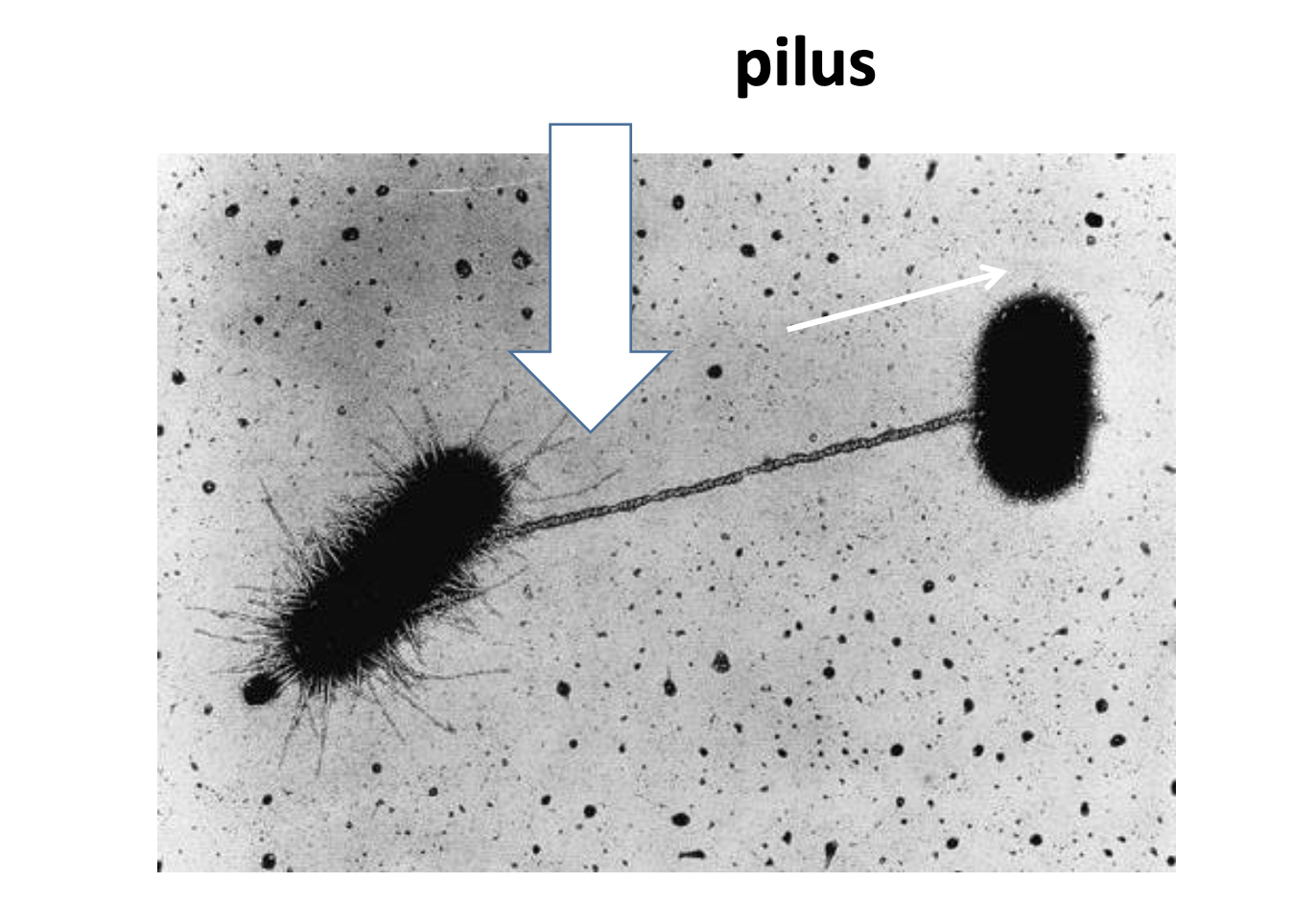
70
New cards
What form of DNA is transmitted during conjugation?
A plasmid is received through conjugation
71
New cards
What is transduction?
**Introduction of DNA to a recipient bacteria which is carried by a bacteriophage**
72
New cards
Compare the three mechanisms of DNA transfer:
1\.natural transformation
2\.conjugation
3\.transduction
4\.transposition
1\.natural transformation
2\.conjugation
3\.transduction
4\.transposition
1\.natural transformation: bacteria take up DNA from environment
2\.conjugation: transfer of Plasmid through pili
3\.transduction: transfer of DNA from bacteriophages
4\.transposition: Integration of DNA with transposons containing IR domains
2\.conjugation: transfer of Plasmid through pili
3\.transduction: transfer of DNA from bacteriophages
4\.transposition: Integration of DNA with transposons containing IR domains
73
New cards
Explain the mechanism of transduction
transduction occurs when a bacteriophage like T2 and T4 attach to the bacteria via a specific receptor, then there is perforation of the cell wall by the phage and injection of DNA into the bacteria.
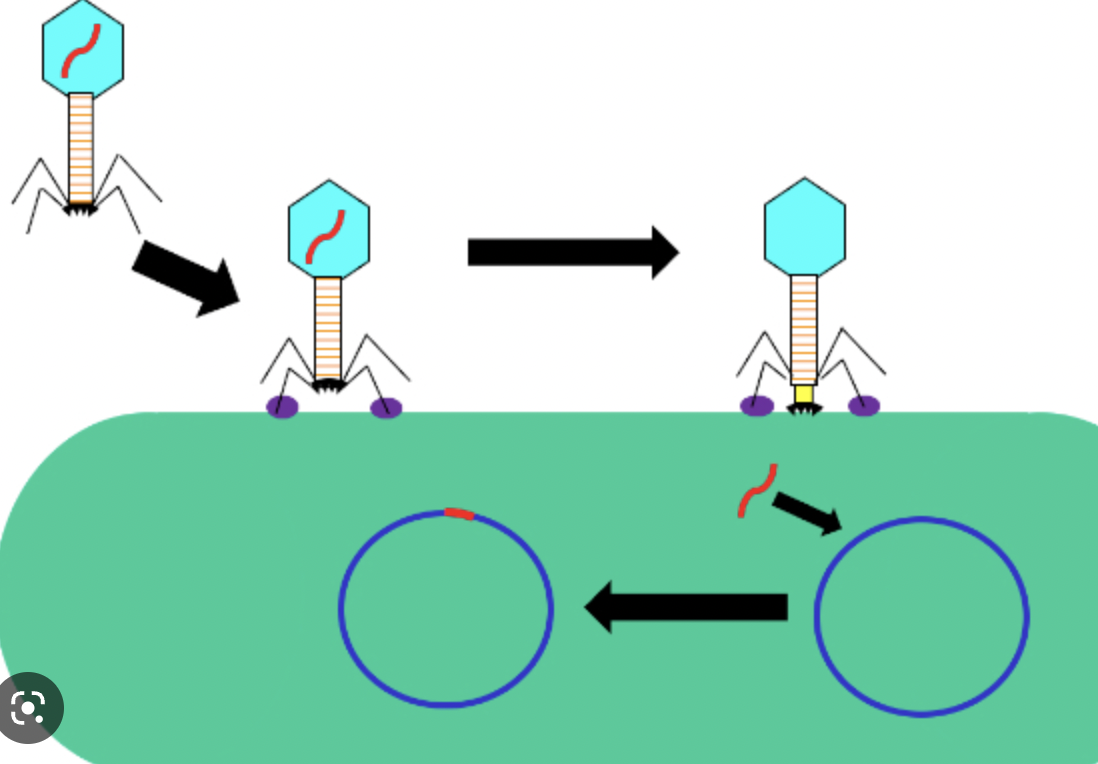
74
New cards
What are the 2 types of transduction?
1\.General
2\.Specific
2\.Specific
75
New cards
What is an Operon?
A cluster of genes that are transcribed together to give a single messenger RNA (mRNA) molecule, which therefore encodes multiple proteins
76
New cards
Draw the lac operon

77
New cards
What are the main domains of the Lac operon?
LacL, LacZ, LacA, Lac Y
78
New cards
How does the lac operon work?
In the absence of lactose, *lacI* gene (regulatory gene for *lac* operon) produces a protein that blocks RNA polymerase from binding to the operator of the operon.This blocks the transcription of the enzymes (Beta-galactosidase, Permease and Transacetylase) because there is no lactose in the environment. This protein can only be removed when allolactose binds to it, and inactivates it. Then, transcription can occur.
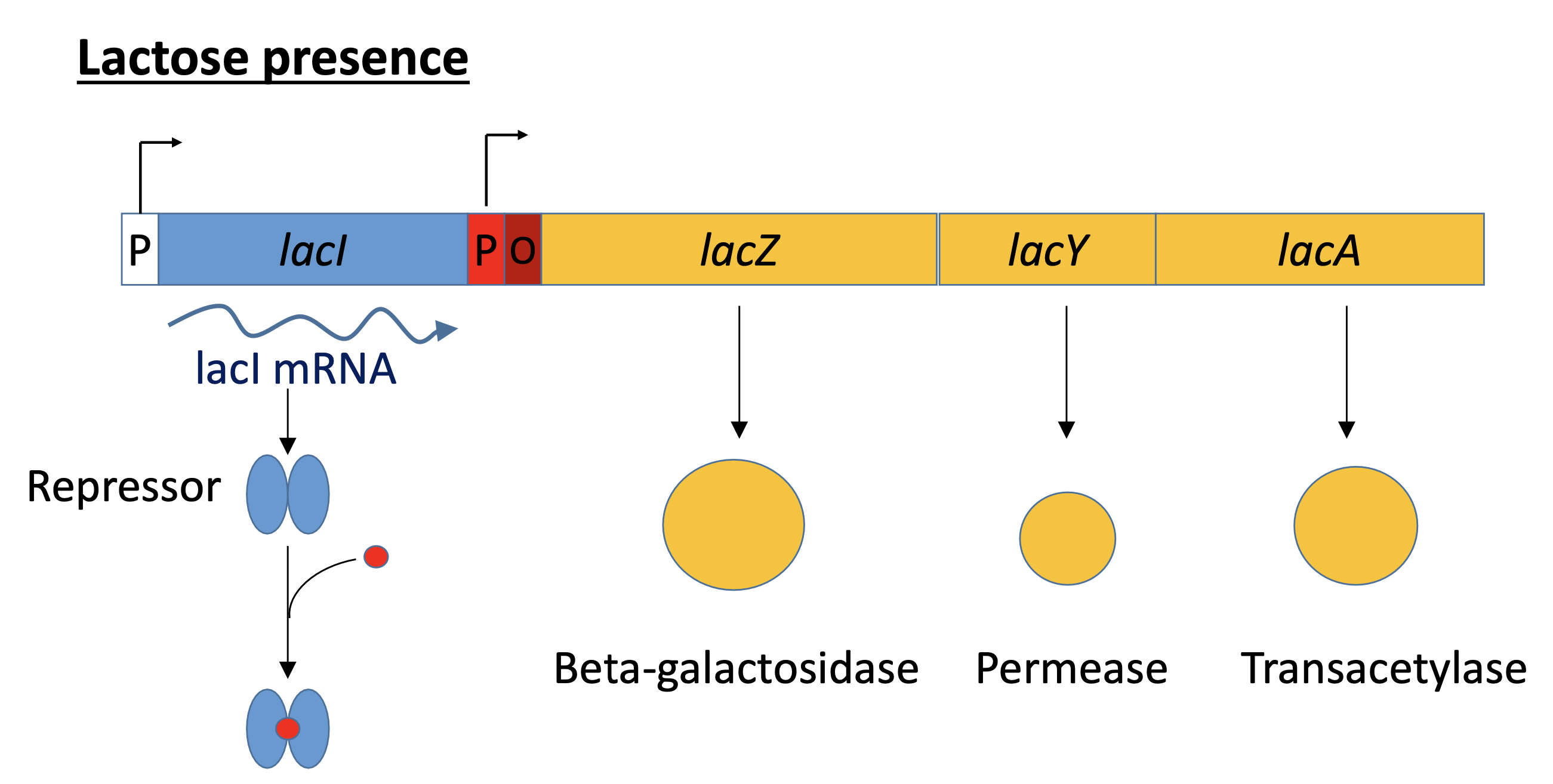
79
New cards
How does the tryptophan operon work?
The *trp* operon is expressed (turned "on") when tryptophan levels are low and repressed (turned "off") when they are high.
The *trp* operon is regulated by the ***trp*** **repressor**. When bound to tryptophan, the *trp* repressor blocks expression of the operon.
The *trp* operon is regulated by the ***trp*** **repressor**. When bound to tryptophan, the *trp* repressor blocks expression of the operon.
80
New cards
What is the difference between the lac and trp operon?
The lac operon is an inducible operon that is **normally turned off**.
The trp operon is a repressible operon that is **normally turned on**
The trp operon is a repressible operon that is **normally turned on**